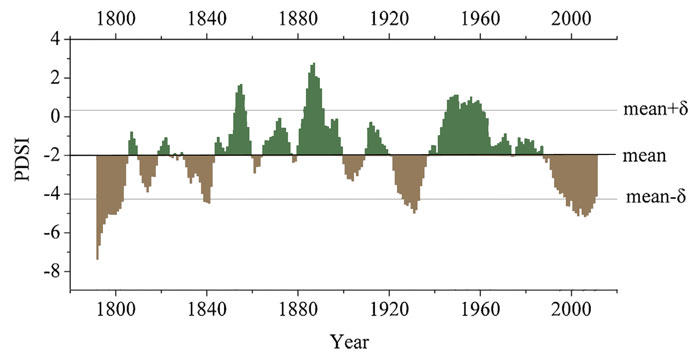| Tweet | Follow @co2science |
Paper Reviewed
Li, V., Wang, S., Niu, J., Fang, K., Chao, Y., Li, X. and Li, Y. 2016. Tree-ring-based reconstruction of drought variability (1792-2011) in the middle reaches of the Fen River, North China. Dendrochronologia 40: 1-11.
Drought events have long been a concern for society, which tends to suffer hardship (e.g., crop failure) during extreme and/or long lasting drought periods. And with claims that CO2-induced global warming is causing more drought, it is pertinent to examine the historical record from as many locations as possible to verify the truth of such claims.
One such study that allows for this type of analysis is that of Li et al. (2016), who developed "a robust May-July Palmer Drought Severity Index (PSDI) reconstruction for 1792-2011" for the middle reaches of the Fen River, North China. In doing so, the seven Chinese scientists collected 52 tree-ring samples from 25 old-growth Chinese pine trees (Pinus tabulaeformis) located in the Tianlong Mountain Natural Reserve (37.73°N, 112.37°E). Then, using signal-free regional curve standardization methods, they were able to construct a history of drought variability in this region since 1792. The resultant chronology (smoothed with an 11-year running average) is shown in the figure below.
According to the authors, there were several years of extremely moist or extremely dry conditions in the record, which conditions were defined as years in which the PSDI values were more than 1.5 standard deviation units above or below the mean of the record. And based on the 11-year smoothed data, as shown in the accompanying figure, epochs with persistently dry years occurred in the 1790s, 1840s, 1920s-1930s and 2000s. In contrast, persistently wet periods occurred in the 1850s, 1880s and 1940s-1950s. Additional examination of the reconstruction using multi-taper spectral analysis revealed statistically significant periodic cycles associated with ENSO and the Pacific Decadal Oscillation, which likely explain much of the PSDI oscillation in the record.
The results of this study place the recent drought event of the 2000s within the long-term perspective of this two-century-long PSDI reconstruction, revealing its occurrence was neither unusual, unnatural, nor suggestive of a change in state due to rising concentrations of atmospheric CO2.

Figure 1. Eleven-year smoothed running average (Fast Fourier Transform) of May-July reconstructed PDSI for the Fen River, North China, over the period 1792-2011. Source: Li et al. (2016).




